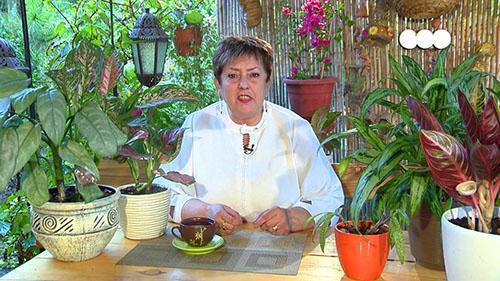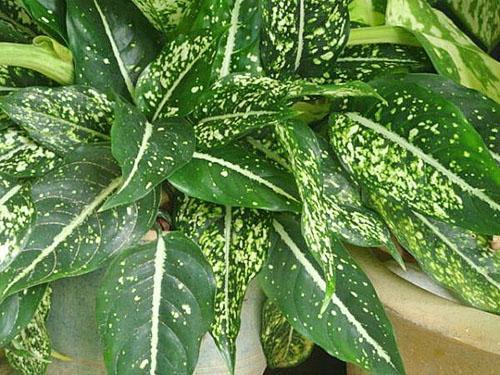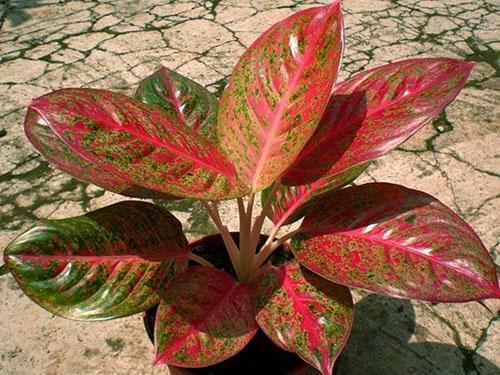Grow aglaonema at home
 Aglaonema is a representative of the distant tropics of the Malay Archipelago and East India, from the Aroid family. Its beautiful decorative leaves and unpretentiousness are appreciated by lovers of floriculture. The genus unites 23 species, they can grow in swamps and in the foothills. The plant fell in love for its extraordinary shade tolerance, motley and multi-colored leaves.
Aglaonema is a representative of the distant tropics of the Malay Archipelago and East India, from the Aroid family. Its beautiful decorative leaves and unpretentiousness are appreciated by lovers of floriculture. The genus unites 23 species, they can grow in swamps and in the foothills. The plant fell in love for its extraordinary shade tolerance, motley and multi-colored leaves.
History and characteristics of the plant

Aglaonems came to Europe in 1885. The English name of the plant Chinesse evergreen in translation means Chinese green, since it was delivered from there. It got its name in translation from Greek as a bright thread. In culture, only hybrid forms are found.
After the case when an amateur in the garden made numbers from dew paths on the leaves, and the owner put them on a lottery ticket and won a large sum, it is believed that aglaonema brings good luck.
Aglonema at home is divorced relatively recently. It was only in the middle of the last century that the Silver Queen hybrid was bred in America. Later found in the Philippines, the Emerald Beauty or Maria variety made it possible to use its relative resistance to low temperatures and small leaves in breeding. In 1974, the Abidjan variety was found on the Ivory Coast. All these varieties made it possible to obtain many hybrids. aglaonema, home care for which is not difficult. The most widespread varieties are Silver Bay, Siam Aurora, Pride of Sumatra, obtained at the very end of the last century.
 Many new plant forms have been obtained in recent years. Most of them are registered in the catalog, but there are unstable ones, with loose signs. This mainly applies to Asian hybrids, which, when multiplied, may lose their decorative effect.
Many new plant forms have been obtained in recent years. Most of them are registered in the catalog, but there are unstable ones, with loose signs. This mainly applies to Asian hybrids, which, when multiplied, may lose their decorative effect.
Aglaonema home care
 The indoor flower is characterized by amateurs as an unpretentious plant, which is due to:
The indoor flower is characterized by amateurs as an unpretentious plant, which is due to:
- shade tolerance:
- a comfortable environment for humans in terms of humidity and ambient temperature;
- rare transplants;
- a small number of pests.
Aglaonema is a danger to children and animals. It produces poisonous berries, and the sap of the plant is acrid, causing swelling of the mucous membrane. The juice is very dangerous if it gets into the eyes. But this plant fights streptococci, absorbs phenolic and benzene impurities from the air, releasing air ions into the atmosphere.
The flower grows slowly, adding 5-6 leaves per year. In the third year, the stems are extended and decorativeness decreases. Therefore, you should use anti-aging pruning of the bush, forming it.
Home care for aglaonema consists of:
- correctly place the plant to the apartment;
- observe the regime glaze and dressing;
- carry out hygiene procedures on time;
- transplant and form a bush in a timely manner;
- eliminate drafts and tobacco smoke.
The ornamental plant is so shade-tolerant that it grows in the most shaded corners of the apartment. She lives in nature in the lower tier of a tropical forest and is used to the shade. In the light, the leaves turn pale and thin. Varieties with red leaves can withstand high illumination, but they cannot stand direct rays either.
 Temperature regime in summer 21-27 0... In winter, at least 15, but at the same time, the lower the temperature of the content, the poorer the winter watering, in order to avoid decay of the roots.
Temperature regime in summer 21-27 0... In winter, at least 15, but at the same time, the lower the temperature of the content, the poorer the winter watering, in order to avoid decay of the roots.
Plant waterbread. The soil should always be moist, a layer of expanded clay in the pot is not required. The plant absorbs a lot of moisture. But if there is an excess, the aglaonema will start crying, and then watering should be temporarily stopped. Even from the overflow, wilting of foliage is possible. The plant is rearranged in a warm place, the earth is dried.
Watering during the growing season should be combined with dressings, which are made with liquid fertilizers for indoor ornamental plants. In winter, watering is reduced to once a week and does not add food.
Planting is carried out in a pot with nutritious and loose soil for bulbous. You can prepare the soil yourself in the following proportions:
- peat;
- leaf humus;
- sod land;
- coarse sand;
- perlite.
All parts are taken in equal amounts. For mature plants, when transplanting, the amount of leaf humus and peat can be increased. The composition for transplanting should be sour, which provides peat and leaf humus.
 A transplant in the care of an aglaonema in the photo is also a way of reproduction. Often, taking apart the roots, they divide the bushes and carry out new plantings. Plants are divided in late spring. A prerequisite for survival is a temperature of at least 21 0... Rooting can be done with the tops of the stems. To do this, they are pinched, dried for a day, rooted in wet sand at a temperature of 20-25 0... Can be propagated by seed, but hybrid varieties do not produce viable seeds.
A transplant in the care of an aglaonema in the photo is also a way of reproduction. Often, taking apart the roots, they divide the bushes and carry out new plantings. Plants are divided in late spring. A prerequisite for survival is a temperature of at least 21 0... Rooting can be done with the tops of the stems. To do this, they are pinched, dried for a day, rooted in wet sand at a temperature of 20-25 0... Can be propagated by seed, but hybrid varieties do not produce viable seeds.
 The pot for the plant is chosen wide; with each transplant, they take large dishes. The signal for transplanting is the state of the plant. If new leaves grow in the middle, and they dry at the edges, water stagnates after watering, it is time to change the soil and dishes.
The pot for the plant is chosen wide; with each transplant, they take large dishes. The signal for transplanting is the state of the plant. If new leaves grow in the middle, and they dry at the edges, water stagnates after watering, it is time to change the soil and dishes.
Home care for aglaonema involves a weekly leaf shower, rubbing the leaves, and spraying the plant to moisturize the air. All water procedures should be carried out with soft warm water. Reception helps to humidify the air around the flower. In order for the plant to be always decorative, you should help it. How to make aglaonema more bushy?
 To do this, from the very beginning of the development of the bush, pinch the upper growth buds in order to organize the appearance of additional leaves. The signs of trouble are:
To do this, from the very beginning of the development of the bush, pinch the upper growth buds in order to organize the appearance of additional leaves. The signs of trouble are:
- gray spots on the leaves - the plant is cold;
- leaves curl, turn black, covered with an oily coating - all from the cold;
- leaves turned pale - strong lighting;
- dry spots on the leaves signal a sunburn;
- the tips of the leaves dry - dry air;
- leaves turn yellow - there is little nutrition, the humidity regime is broken, the plant is old, drafts or tobacco smoke.
 With waterlogging and cold, the appearance of rot is possible, from pests you need to pay attention to the presence of a worm, aphids and scale insects. The plant is almost not affected by pests and infectious diseases.
With waterlogging and cold, the appearance of rot is possible, from pests you need to pay attention to the presence of a worm, aphids and scale insects. The plant is almost not affected by pests and infectious diseases.